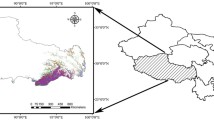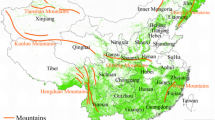Abstract
There are many uncertainties in the estimation of forest carbon sequestration in China, especially in Liaoning Province where various forest inventory data have not been fully utilized. By using forest inventory data, we estimated forest vegetation carbon stock of Liaoning Province between 1993 and 2005. Results showed that forest biomass carbon stock increased from 68.91 Tg C in 1993 to 97.51 Tg C in 2005, whereas mean carbon density increased from 18.48 Mg·ha−1 C to 22.33 Mg·ha−1 C. The carbon storage of young- and middle-aged forests increased by 22.1 Tg C and 5.95 Tg C, but that of mature forests has decreased by 0.25 Tg C. The carbon stock and density of forests in Liaoning Province varied greatly in space: larger carbon storage and higher carbon density were primarily found in the east area. The spatial distribution of carbon density was determined by many factors, of which human activities played an important role. The forests in Liaoning Province played a positive role as a sink of atmospheric carbon dioxide. The carbon fixation ability of forests in this area was primarily derived from forest plantation and the total forest carbon sequestration can be enhanced by expanding young- and middle-aged forests.
Similar content being viewed by others
References
Bai Xueshuang, Hu Yalin, Zeng Dehui, Jiang Zhirong. 2008. Effects of farmland afforestation on ecosystem carbon stock and its distribution pattern in semi-arid region of Northwest China. Chinese Journal of Ecology, 27(10): 1647–1652. (in Chinese)
Brown S, Schroeder PE, Birdsey R. 1997. Aboveground biomass distribution of US Eastern hardwood forests and the use of large trees as an indicator of forest development. Forest Ecology and Management, 96: 37–47.
Brown SL, Schroeder P, Kern JS. 1999. Spatial distribution of biomass in forests of the eastern USA. Forest Ecology and Management, 123: 81–90.
Dixon RK, Brown S, Houghton RA, Trexier MC, Wisniewski J. 1994. Carbon pools and flux of global forest ecosystems. Science, 263: 185–190.
Dong Houde. 1987. Vegetation regionalization for Liaoning Province. Shenyang: Liaoning University Publication. (in Chinese)
Fang **gyun, Brown S, Tang Yanhong, Nabuus GJ, Wang **, Shen Haihua. 2006. Overestimated biomass carbon pools of the northern mid-and high latitude forests. Climatic Change, 74: 355–368.
Fang **gyun, Chen An**, Peng Changhui, Zhao Shuqing, Ci Longjun. 2001. Changes in forest biomass carbon storage in China between 1949 and 1998. Science, 292: 2320–2322.
Fang **gyun, Liu Guohua, Xu Songling. 1996. Biomass and net production of forest vegetation in China. Acta Ecologica Sinica, 16(5): 497–508.
Feng Yiming. 2008. The theory of spatial statistics and its application in forestry. Bei**g: Chinese Forestry Press. (in Chinese)
Forestry Researching and Planning Institute of Liaoning Province (FRPILP). 2008. Forestry Atlas of Liaoning. Bei**g: Chinese Forestry Press, p.12–28. (in Chinese)
Galik CS, Jackson RB. 2009. Risks to forest carbon offset projects in a changing climate. Forest Ecology and Management, 257: 2209–2216.
Gu Kai**, Zhang Kun, Zhang Lixia. 2008. Researches on estimation method of forest carbon sequestration. Journal of Nan**g Forestry University (Natural Sciences Edition), 32(5): 105–109. (in Chinese)
Hannes B, Werner AK, Annette F. 2008. Accounting of forest carbon sinks and sources under a future climate protocol-factoring out past disturbance and management effects on age-class structure. Environmental Science & Policy, 11: 669–686.
Huang Congde, Zhang Jian, Yang Wanqin, Tang **ao, Zhang Guoqing. 2009. Spatial differentiation characteristics of forest vegetation carbon stock in Sichuan Province. Acta Ecologica Sinica, 29(9): 5115–5121.
Huang Dong. 2008. Carbon sequestration by forest will be one of the important approaches for the reduction of CO2 emission after Kyoto Protocol. Forestry Economics, 10: 12–15.
Jiao Yan, Hu Haiqing. 2005. Carbon storage and its dynamics of forest vegetation in Heilongjiang Province. Chinese Journal of Applied Ecology, 16(12): 2248–2252. (in Chinese)
Johnson WC, Sharpe DM. 1983. The ratio of total to merchantable forest biomass and its application to the global carbon budget. Canadian Journal of Forest Research, 13: 372–383.
Kim YH, Sohngen B. 2009. Assessing the uncertainty of land based carbon sequestration: A parameter uncertainty analysis with a global land use model. Research in Agricultural & Applied Economics (http://purl.umn.edu/49416).
Lin Qingshan, Hong Wei. 2009. Summary of research on forest carbon storage in China. Chinese Agricultural Science Bulletin, 25(06): 220–224. (in Chinese)
Lv **ghui, Ren Tianzhong, Yan Deren. 2008. Domestic research on forest carbon sinks. Journal of Inner Mongolia Forestry Science & Technology, 34(2): 43–47.
Ma Qinyan, Chen **alin, Wang Juan, Lin Chen, Kang Fengfeng, Cao Wenqiang, Ma Zhibo, Li Wenyu. 2002. Analysis of carbon content percentage of dominant species in the main forest type of North China. Journal of Bei**g Forestry University, 24(5/6): 97. (in Chinese)
Malhi Y, Meir P and Brown S. 2002. Forests, carbon and global climate. Phil. Trans. R. Soc. Lond, 360(1797): 1567–1591.
Montagnini F, Porras C. 1998. Evaluating the Role of Plantations as Carbon Sinks: An Example of an Integrative Approach from the Humid Tropics. Environmental Management, 22(3): 459–470.
Oijen MV, Thomson A. 2010. Toward Bayesian uncertainty quantification for forestry models used in the United Kingdom Greenhouse Gas Inventory for land use, land use change, and forestry. Climatic Change, 103(1–2): 55–67.
Pan Yude, Luo Tianxiang, Birdsey R, Hom J, Melillo J. 2004. New estimates of carbon storage and sequestration in China’s forests: effects of age-class and method on inventory-based carbon estimation. Climate Change, 67: 211–236.
Tang Lina, Wang Qingli, Shao Guofan, Dai Limin, Wang Shunzhong, Li **ufen, Xu Dong. 2006. Digitally determining forest inventory units with an ecological classification system. Science in China: Series E Technological Sciences, 49: 118–127.
Wang Pengcheng, **ng Lejie, **ao Wenfa, Huang Zhilin, Pan Lei, Zeng Lixiong. 2009. Organic carbon density and storage of forest ecosystems in Three Gorges Reservoir Area. Acta Ecologica Sinica, 29(1): 97–107.
Wang Qingli, Deng Hongbing. 2002. Review of forest ecology studies in China. Journal of Forestry Research, 13(3): 231–234.
Wang **aoke. 1996. Carbon pool and fires-released carbon-containing gases in forest ecosystems of China. Dissertation for Ph. D. Bei**g: Research Center for Eco Environmental Sciences, Chinese Academy of Sciences. (in Chinese)
Wang **aoke, Feng Zongwei, Ouyang Zhiyun. 2001. Vegetation carbon storage and density of forest ecosystems in China. Chinese Journal of Applied Ecology, 12(1): 13–16. (in Chinese)
Wang **uyun, Sun Yujun. 2008. Review on research and estimation methods of carbon storage in forest ecosystem. World Forestry Research, 21(5): 24–29.
Wang Xuejun, Huang Guosheng, Sun Yujun, Fu **ao, Han Aihui. 2008. Forest carbon storage and dynamics in Liaoning Province from 1984 to 2000. Acta Ecologica Sinica, 28(10): 4757–4764.
Woodbury PB, Smith JE, Heath LS. 2007. Carbon sequestration in the U.S. forest sector from 1990 to 2010. Forest Ecology and Management, 241: 14–27.
Wu Qingbiao, Wang **aoke, Duan **aonan, Deng Libin, Lu Fei, Ouyang Zhiyun, Feng Zongwei. 2008. Carbon sequestration and its potential by forest ecosystems in China. Acta Ecologica Sinica, 28(2): 517–524.
Xu Fei, Liu Weihua, Ren Wenling, Zhong Qicheng, Zhang Guilian, Wang Kaiyun. 2010. Effects of community structure on carbon fixation of urban forests in Shanghai, China. Chinese Journal of Ecology, 29(3): 439–447. (in Chinese)
Xu **nliang, Cao Mingkui, Li Kerang. 2007. Temporal-spatial dynamics of carbon storage of forest vegetation in China. Progress in Geography, 26(6): 1–8.
Yan **aodong, Zhao Junfang. 2007. Establishing and validation individual-based carbon budged model FORCCHN of forest ecosystems in China. Acta Ecologica Sinica, 27(7): 2684–2694.
Yang Hongxiao, Wu Bo, Zhang **tun, Lin Derong, Chang Shunli. 2005. Progress of research into carbon fixation and storage of forest ecosystems. Journal of Bei**g Normal University (Natural Science), 41(2): 172–177. (in Chinese)
Yin Runsheng, Roger Sedjo, Liu **. 2010. The potential and challenges of sequestering carbon and generating other services in China’s forest ecosystems. Environ Sci Technol, 44: 5687–5688.
Zhao Junfang, Yan **aodong, Jia Gensuo. 2009. Simulation of carbon stocks of forest ecosystems under the future climate scenario in Northeast China based on FORCCHN. Scientia Geographica Sinica, 29(5): 690–696.
Zhao Min, Zhou GuangSheng. 2004. Carbon storage of forest vegetation and its relationship with climate factors. Scientia Geographica Sinica, 24(1): 50–53.
Zhou Yurong, Yu Zhenliang, Zhao Shidong. 2000. Carbon storage and carbon balance in the main forest ecosystem in China. Chinese Journal of Plant Ecology, 24(5): 518–522. (in Chinese)
Author information
Authors and Affiliations
Corresponding author
Additional information
Foundation project: The present work was supported by Fujian Provincial Science and Technology Project (2010H0020) and Environmental Public-benefit Project (201009055) by providing financial assistance.
The online version is available at http://www.springerlink.com
Rights and permissions
About this article
Cite this article
Li, Q., Tang, LN. & Ren, Y. Temporal dynamics and spatial variations of forest vegetation carbon stock in Liaoning Province, China. Journal of Forestry Research 22, 519–525 (2011). https://doi.org/10.1007/s11676-011-0195-3
Received:
Accepted:
Published:
Issue Date:
DOI: https://doi.org/10.1007/s11676-011-0195-3




